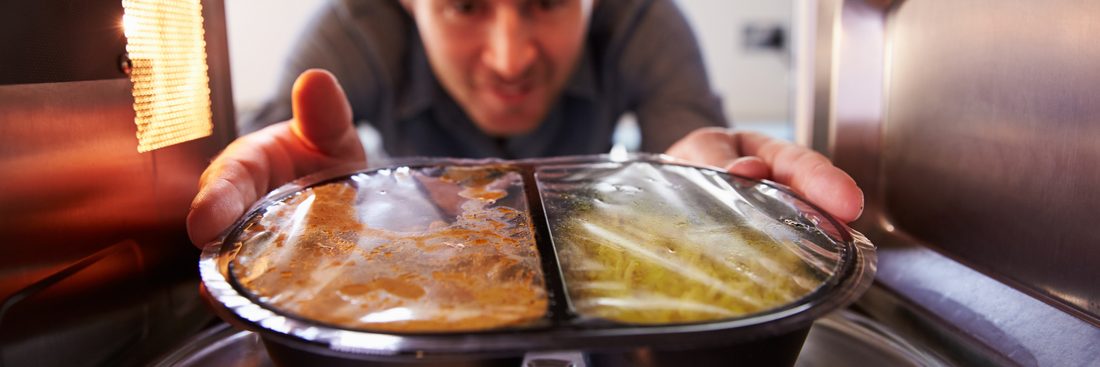Plastic wrap also known as cling film is a household essential for covering food, preventing spills, and extending freshness. But when it comes to reheating food, many people ask the same question: Is plastic wrap safe for microwave use?
The answer isn’t as simple as “yes” or “no.” It depends on the type of wrap you’re using, how you’re heating your food, and whether the wrap carries the microwave safe plastic symbol. In this guide, we’ll break down the science, safety guidelines, and best alternatives so you can make informed choices for your kitchen and your health.
- Fried Chicken Packaging: Best Eco-Friendly Boxes & Custom Design Ideas
-
What Is Stretch Wrap? A Complete Guide for Logistics & Packaging Professionals
Understanding Plastic Wrap and Microwave Safety

What is plastic wrap?
Plastic wrap is a thin, transparent film made from various plastics such as PVC (polyvinyl chloride), LDPE (low-density polyethylene), or PVdC (polyvinylidene chloride). Its primary purpose is to seal containers and wrap food, preventing air exposure and moisture loss.
While plastic wrap excels at cold storage, heat changes its physical and chemical properties which is why microwave safety becomes a concern.
Plastic Wraps: Green & Optimized Packaging Solutions for Your Business
How microwaves heat food
Microwaves work by emitting electromagnetic waves that excite water molecules in food, producing heat from the inside out. This heat can create steam, which builds pressure under the plastic wrap. If the wrap is not designed for high heat, it can soften, melt, or release unwanted chemicals into the food.
Key takeaway: Not all wraps are created equal, and the wrong kind could pose health risks when heated.
Is Plastic Wrap Microwave Safe?

The short answer
Not all plastic wraps can handle microwave heat. Only products labeled as microwave safe plastic wrap have undergone safety testing for high temperatures and food contact.
How heat affects plastic wrap
- Softening or melting: High heat can cause the film to lose shape and stick to food.
- Chemical migration: Certain plastics may release plasticizers or other compounds when heated, especially with fatty or oily foods.
- Flavor transfer: Heat can cause a faint “plastic” odor or taste if the wrap is not heat-stable.
FDA & global safety guidelines
The U.S. Food and Drug Administration (FDA) requires that microwave safe plastic wraps meet strict food-contact standards. Similar guidelines exist in the EU, Canada, and Australia.
A wrap that is both food-grade and microwave safe ensures it can withstand typical microwave temperatures (up to about 248°F / 120°C) without melting or leaching harmful substances.
How to Identify Microwave Safe Plastic Wrap

Look for the “microwave safe plastic symbol”
The easiest way to tell if your wrap is safe for microwave use is to check the box for the microwave safe plastic symbol usually represented by a microwave icon or wavy lines. This mark means the product has passed laboratory tests for microwave use.
Reading packaging labels
Even without the symbol, many wraps will include explicit wording like “Microwave Safe” or “Safe for Reheating.” If you don’t see this, assume the product is not microwave safe. Remember: “Food-grade” only guarantees safety at cold or room temperatures, not during heating.
Materials to avoid
Avoid using wraps made with PVC that are not certified microwave safe. Instead, look for LDPE or specially formulated polyethylene wraps, which generally handle heat better.
Best Practices for Using Plastic Wrap in the Microwave

Even if your wrap is microwave safe, how you use it matters:
- Avoid direct contact with food: Keep at least 1 inch (2–3 cm) between the wrap and the food surface. Use a bowl deep enough to prevent the wrap from touching.
- Leave a vent for steam: Peel back one corner or poke a small hole to allow steam to escape, preventing pressure build-up.
- Lower the microwave power setting: Medium or medium-high heat for longer periods is safer than blasting on high.
- Be careful with high-fat or high-sugar foods: Butter, cheese, and syrups heat faster than water and can cause melting.
What to Use Instead of Plastic Wrap in the Microwave

If you prefer to avoid plastic wrap entirely, here are excellent alternatives:
5.1 Reusable silicone lids & covers
Made from food-grade silicone, these are heat-resistant, flexible, and long-lasting. They stretch over bowls or plates and are dishwasher-safe.
5.2 Microwave-safe glass or ceramic covers
Pyrex dishes, tempered glass lids, and vented ceramic covers provide full protection without any risk of melting or chemical migration.
5.3 Beeswax wraps
Perfect for cold storage or room temperature use, beeswax wraps are biodegradable and reusable but not suitable for microwaving due to melting risk.
Tip: For reheating, even a simple paper towel can be used to prevent splatters without the need for plastic.
FAQ – Your Microwave Plastic Wrap Questions Answered
Q1: Can all cling films be microwaved?
A: No. Only those labeled “microwave safe” are recommended for use in the microwave.
Q2: Is it safe to reuse microwave safe plastic wrap?
A: Not advisable reheating may weaken the film and reduce its safety.
Q3: Does “BPA-free” mean microwave safe?
A: No. BPA-free simply means the product does not contain bisphenol A; it doesn’t guarantee heat resistance.
Q4: Why do some wraps stick to food when microwaved?
A: Direct contact with hot, moist food can soften the wrap, causing it to cling.
Conclusion
Plastic wrap can be safe in the microwave but only if it’s clearly marked as microwave safe plastic wrap and used properly. Always check for the microwave safe plastic symbol, avoid direct contact with food, and vent for steam.
If you want a zero-risk approach, choose alternatives like silicone lids or glass covers. These not only reduce the chance of chemical exposure but also help you cut down on single-use plastics.




